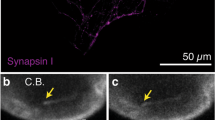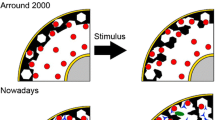Abstract
Guinea-pig oxyntic cell tubulin has been isolated andin vitro aggregation has been studied. The spontaneous assembly of isolated tubulin was significantly accelerated and increased bt 1 mmol/l GTP. Histamine and forskolin increased tubulin polymerization only when detergent dispersed oxyntic cells or crude membranes were added. The forskolin response occurred very rapidly with an EC50 of approximately 30 μmol/l and did not require GTP. Histamine promoted tubulin aggregation with an EC50 of about 5 μmol/l only in the presence of GTP. Ranitidine completely inhibited the effects of histamine. From these data it is suggested that, in the oxyntic cell, histamine H2-receptor activated adenylate cyclase and the corresponding increase in cAMP play a role in eliciting characteristic ultrastructural changes by initiating formation of microtubules as a first step in the cascade of events leading to an increase in the secretory surface area.
Similar content being viewed by others
References
M. T. Forte, T. E. Machen and J. G. Forte,Ultrastructural changes in oxyntic cells associated with secretory function: A membrane-recycling hypothesis. Gastroenterology73, 941–955 (1977).
H. E. Stewart and D. K. Kasbekar,Gastric oxyntic cell tubulin: characterization and possible significance. Am. J. Physiol.240, G317-G323 (1981).
M. Albinus and D. Winne,Subclasses of muscarinic receptors in isolated gastric mucosal cells: receptor characterization and parietal cell function. Eur. J. Pharmacol.94, 281–295 (1983).
O. H. Lowry, N. J. Rosebrough, A. L. Farr and R. J. Randall,Protein measurement with the Folin phenol reagent. J. biol. Chem.193, 265–275 (1951).
G. G. Borisy, J. B. Olmsted and R. A. Klugman,In vitro aggregation of cytoplasmic microtubule subunits. Proc. natl. Acad. Sci.69, 2890–2894 (1972).
L. Armbruckner and M. Albinus,Characterization of parietal cell tubulin polymerization in vitro. 10th Int. Congr. Pharmacol., Sydney, Australia P1512 (1987).
K. B. Seamon and J. W. Daly,Forskolin, cyclic AMP and cellular physiology. Trends Pharmacol. Sci.4, 120–123 (1983).
Author information
Authors and Affiliations
Rights and permissions
About this article
Cite this article
Albinus, M., Armbruckner, L., Klein, S. et al. The possible role of histamine-mediated cAMP formation as a link between H2-receptor stimulation and ultrastructural changes in guinea-pig oxyntic cells. Agents and Actions 27, 173–176 (1989). https://doi.org/10.1007/BF02222231
Issue Date:
DOI: https://doi.org/10.1007/BF02222231




